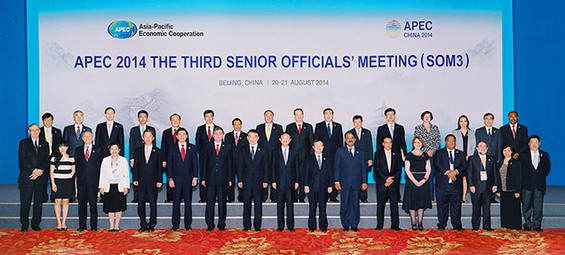The rebirth of APEC
- By An Gang
 0 Comment(s)
0 Comment(s) Print
Print E-mail Beijing Review, October 22, 2014
E-mail Beijing Review, October 22, 2014
When Singapore, New Zealand and Chile announced the official launch of the Pacific Three Closer Economic Partnership (P3-CEP) negotiations 12 years ago during the Economic Leaders' Meeting of the Asia-Pacific Economic Cooperation (APEC) in Mexico, they could not have anticipated that their cooperation initiative would one day spiral into a geopolitical competition.
|
|
|
2014 APEC Third Senior Officials' Meeting (SOM3) in Beijing |
The initial aim of the P3-CEP negotiation was to explore a voluntary free trade project under the APEC framework.
In 1994, the APEC leaders' meeting held in Bogor, Indonesia, set goals for industrialized member economies to achieve a system of free and open trade and investment by 2010 and for developing economies to do the same by 2020. Later, the Vancouver leaders' meeting in Canada in 1997 endorsed a proposal for Early Voluntary Sectoral Liberalization in 15 sectors. However, due to the Asian financial crisis in 1997-98 and the international financial crisis in 2008-09, a new wave of protectionism emerged, thus slowing the trade liberalization among APEC members. Additionally, the WTO-sponsored Doha Round of multilateral trade negotiations also reached an impasse. Against this backdrop, some small and middle-sized economies that firmly support trade liberalization and economic globalization decided to commit to smaller-scale multilateral trade liberalization practices. Regional and sub-regional, bilateral and multilateral free trade negotiations have since sprung up gradually.
With the addition of Brunei in 2005, P3-CEP developed into the Trans-Pacific Strategic Economic Partnership Agreement (TPSEP).
Washington's wishes
In 2008, the George W. Bush administration expressed the United States' interest in joining TPSEP negotiations and gradually promoted it into a proposed Trans-Pacific Partnership (TPP). In 2009, the U.S. Government led by President Barack Obama officially announced participation in TPP talks. So far, 12 countries have joined the negotiations over a total of 21 rounds.
Though the United States was a latecomer in TPP negotiations, it has used its influence to dominate the scene and pressure all participants to reach a framework agreement by the end of this year. The Obama administration's enthusiasm for the proposed agreement is driven by both trade and strategic concerns. The United States is determined to forge the TPP into a high-quality, high-standard and broad-based free trade agreement. In addition to traditional trade and investment liberalization issues, the TPP will also involve regulation of financial services, government procurement, intellectual property protection, state-owned enterprises, market access, environment, labor issues, and so on, which will not only facilitate the expansion of U.S. exports but also set new standards for global trade.







Go to Forum >>0 Comment(s)